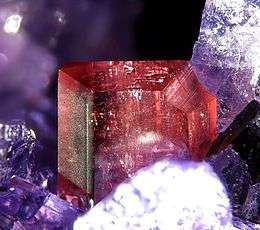Phosphosiderite
Phosphosiderite is a rare mineral named for its main components, phosphate and iron. The siderite at the end of phosphosiderite comes from "sideros", the Greek word for iron. It was discovered in 1890. It is mined in some parts of Chile, Argentina, Germany, Portugal, and the United States. It is totally soluble in hydrochloric acid and nearly insoluble in nitric acid.[1][2]
| Phosphosiderite | |
|---|---|
 Red phosphosiderite between violet strengite. Picture width 4 mm. | |
| General | |
| Category | Phosphate minerals |
| Formula (repeating unit) | hydrated iron phosphate FePO4•2H2O |
| Crystal system | Monoclinic |
| Crystal class | Prismatic |
| Identification | |
| Color | Usually red to pink to purple, sometimes green, usually yellow veined |
| Crystal habit | tabular {010} or stout prismatic [001] |
| Twinning | common on {101}, typically as interpenetration |
| Cleavage | {010} Distinct, {001} Indistinct |
| Fracture | uneven |
| Mohs scale hardness | 3.5–4 |
| Luster | Vitreous |
| Streak | White |
| Diaphaneity | Transparent, translucent |
| Specific gravity | 2.74-2.76 |
| Optical properties | Biaxial |
| Refractive index | 1.692-1.739 |
| Birefringence | 0.046 |
References
- "Phosphosiderite". National Gem Lab. 18 March 2017.
- Anthony et al, Handbook of Mineralogy (2001)
This article is issued from Wikipedia. The text is licensed under Creative Commons - Attribution - Sharealike. Additional terms may apply for the media files.